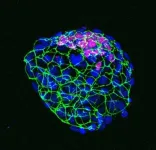Embryos in hungry mouse mums postpone development
2024-04-11
(Press-News.org) It’s challenging to sustain a pregnancy when food is short, or conditions are otherwise tough. That’s why many mammalian embryos can postpone their growth to get through periods of environmental stress and then re-enter development when conditions improve. This stalling of development is known as embryonic diapause, and understanding the mechanisms behind it might help improve infertility treatments, such as embryo freezing. Now, researchers at the Center for Excellence in Brain Science and Intelligence Technology, the Chinese Academy of Sciences in Shanghai, China, have discovered how nutrient depletion is sensed by embryos growing in hungry mouse mums to induce diapause. They publish their study in the journal Development on 11 April 2024.
Lack of food is a known trigger of embryonic diapause, but it has not been clear how nutrient depletion in the mother’s diet is sensed by the embryo. “Seasonal starvation is one of the universal environmental stresses in nature,” explained Professor Qiang Sun, who led the study. “However, the regulatory process of diapause in early-stage embryos is not fully understood. So, we decided to examine whether nutrient deprivation induces embryonic diapause.”
By comparing hungry and well-fed pregnant mice, the team discovered that embryos in the hungry mice did not implant into the uterus and their growth paused at an early timepoint, when the embryo comprises a hollow ball of cells called the blastocyst. These embryos remained viable and could start developing again when transplanted into a well-fed mother.
To work out which nutrients were important to induce diapause, the researchers grew early-stage mouse embryos in dishes that contained different nutrients. They found that embryos grown in dishes lacking protein or carbohydrates paused their development, whereas the embryos exposed to normal nutrient levels did not stall and kept on developing. The scientists then went on to reveal that nutrient sensors in the embryo can detect drops in protein or carbohydrate levels, which triggers the entry into diapause.
The finding that embryos grown without protein or carbohydrates can pause their development means that they can survive longer in the lab. In the future, this finding might lead to improvements in fertility treatments, which currently include approaches such as embryo freezing. “We think our study can inspire the development of new methods for human embryo preservation,” said Professor Sun. “Embryo cryopreservation is a widely used approach, but there is still no consensus on when cryopreserved embryos can be thawed and transferred into the uterus. Many clinical studies have shown that traditional frozen embryo transfer can increase the risk of problems during pregnancy. Therefore, it is necessary to develop alternative methods to preserve embryos.”
Studies focusing on diapause may even have long-term implications for cancer treatments. “Dormant cancer cells which persist after chemotherapy resemble the diapaused embryos,” said Professor Sun. “Consequently, we hypothesize that delving into the mechanism of diapause may have positive implications for cancer treatment and decreasing the chances of relapse.”
###
IF REPORTING THIS STORY, PLEASE MENTION DEVELOPMENT AS THE SOURCE AND, IF REPORTING ONLINE, PLEASE CARRY A LINK TO: https://journals.biologists.com/dev/article-lookup/DOI/10.1242/dev.202091
IMAGE CAPTION: A mouse embryo (blastocyst) that has paused its development due to nutrient depletion. Image credit: Jiajia Ye.
REFERENCE: Jiajia Ye, Yuting Xu, Qi Ren, Lu liu and Qiang Sun (2024). Nutrient deprivation induces mouse embryonic diapause mediated by Gator1 and Tsc2. Development, 151, dev202091 doi: 10.1242/dev.202091
The story is COPYRIGHTED. Therefore, advance permission is required before any and every reproduction of each article in full. Please contact: permissions@biologists.com.
THIS ARTICLE IS EMBARGOED UNTIL Thursday 11th April 2024, 17:00 HRS EDT (22:00 HRS BST)
END
ELSE PRESS RELEASES FROM THIS DATE:
2024-04-11
LA JOLLA, CA—Most disease-causing bacteria are known for their speed: In mere minutes, they can double their population, quickly making a person sick. But just as dangerous as this rapid growth can be a bacterium’s resting state, which helps the pathogen evade antibiotics and contributes to severe chronic infections in the lungs and blood, within wounds, and on the surfaces of medical devices.
Now, Scripps Research scientists have discovered how long chains of molecules called polyphosphates (polyP) are needed for bacteria to slow down movements within cells and let them enter this resting ...
2024-04-11
SAN ANTONIO, April 10, 2024 – The University of Texas Health Science Center at San Antonio (UT Health San Antonio) has appointed Anthony Francis, a renowned leader in translating research to market opportunity, as associate vice president for innovation and development in the Office of the Vice President for Research.
He joins the institution from the University of California San Francisco, where he was executive director of the Office of Technology Management and Advancement. Francis is credited with transforming ...
2024-04-11
Researchers from the International Blast Injury Research Network at the University of Southampton conducted a survey to understand how the mental health of displaced Ukrainians has been affected by the ongoing war. Their findings, published in PLOS Global Public Health, describe high levels of post-traumatic stress disorder (PTSD) and generalized anxiety among both refugees and people displaced within Ukraine.
Since the Russian invasion of Ukraine began in February 2022, at least 13 million people have been displaced from their homes. Both exposure ...
2024-04-11
Image-based artificial intelligence spots parasitic worm infections in children's stool samples, particularly light intensity infections that may be missed by manual microscopy.
#####
Article URL: http://journals.plos.org/plosntds/article?id=10.1371/journal.pntd.0012041
Article Title: Diagnosis of soil-transmitted helminth infections with digital mobile microscopy and artificial intelligence in a resource-limited setting
Author Countries: Finland, Kenya, Sweden
Funding: This research was financially supported by The Erling-Persson Foundation (grant number 2021 0110) JL, Vetenskapsrådet (grant number 2021-04811) JL, Finska Läkaresällskapet ...
2024-04-11
What if changes in a person’s stress levels could be detected while they sleep using wearable devices? A new study by University of Vermont researchers published today in PLOS Digital Health is the first to find changes in perceived stress levels reflected in sleep data—an important step towards identifying biomarkers that may help flag individuals in need of support.
Given how critical sleep is to physical and mental health, the research team suspected signals might exist in sleep data, says Laura Bloomfield, a research assistant professor of mathematics and statistics and lead author of the study. “Changes in stress are visible.”
When parsing baseline sleep ...
2024-04-11
When astronomers looked at a stellar pair at the heart of a stunning cloud of gas and dust, they were in for a surprise. Star pairs are typically very similar, like twins, but in HD 148937, one star appears younger and, unlike the other, is magnetic. New data from the European Southern Observatory (ESO) suggest there were originally three stars in the system, until two of them clashed and merged. This violent event created the surrounding cloud and forever altered the system’s fate.
“When doing background reading, ...
2024-04-11
Shedding light on why some massive stars have magnetic fields even though these stars’ interiors layers don’t undergo convection, researchers report observational evidence that magnetic fields form in some such stars through stellar mergers. The magnetic fields of low-mass stars, like the Sun, are produced by a dynamo generated in the convective layers of the star’s interior. Massive stars – those 8 or more solar masses at formation – do not have the convective interiors required to sustain magnetic fields in ...
2024-04-11
Thin oil films absorbed onto the surface of water droplets lead to anomalously stable, surfactant-free oil and water mixtures, according to a new study. The findings demonstrate a mechanism for stabilizing water droplets in a water-oil emulsification without the need for a surfactant, which could have important technological applications, including the creation of very pure and controlled materials. Oil and water cannot form homogenous mixtures. Instead, when combined, droplets of one fluid will disperse inside the other, forming ...
2024-04-11
New US federal legislation sets aside nearly $14 billion for 574 federally recognized indigenous nations and villages, which can be used to support tribal climate responsiveness and energy sovereignty. In a Policy Forum, Kimberly Yazzie and colleagues present a roadmap for designing, implementing, and funding projects and people to accelerate the renewable energy transition while also benefiting the indigenous entities involved. According to the authors, this opportunity positions indigenous communities to develop their economies and energy projects ...
2024-04-11
A nitrogen-fixing bacterial endosymbiont of marine algae is evolving into a nitrogen-fixing organelle, or nitroplast, according to a new study, thereby expanding a function that was thought to be exclusively carried out by prokaryotic cells to eukaryotes. Eukaryotic cells are remarkably complex and contain various organelles, which are specialized structures within a living cell that have specific biological functions. Two organelles, mitochondria and chloroplasts, play a key role in energy metabolism and ...
LAST 30 PRESS RELEASES:
[Press-News.org] Embryos in hungry mouse mums postpone development






